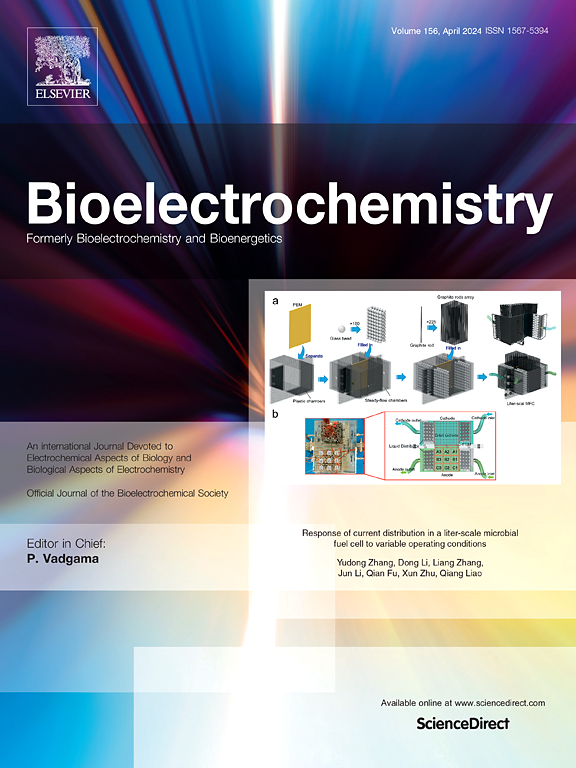Rolling circle amplification and CRISPR/Cas14a with nanozyme for electrochemical detecting miRNA-205 in NPC-derived exosomes
IF 4.5
2区 化学
Q1 BIOCHEMISTRY & MOLECULAR BIOLOGY
引用次数: 0
Abstract
Nasopharyngeal carcinoma (NPC) is a highly malignant tumor, and early detection of biomarkers like miRNA-205 (miR-205) is critical for improving prognosis. However, accurate detection of miR-205 remains challenging due to its low abundance and matrix interference. Herein, an ultrasensitive electrochemical biosensor integrating Pt nanowires/MXene (PtNWs/MXene), rolling circle amplification (RCA), and CRISPR/Cas14a was developed for detecting exosomal miR-205. The dual characteristics of PtNWs/MXene (differential adsorption capacity for intact and cleaved DNA; HRP-like nanozyme activity) enable the conversion of the miR-205-triggered RCA-Cas14a cascade reaction into significant electrochemical signal changes. This biosensor eliminates the requirement for signal probe labeling of the electrode-modified DNA. Moreover, the enzyme-mimicking catalytic activity of PtNWs/MXene enables the catalysis of numerous 3,3′,5,5′-tetramethylbenzidine (TMB) molecules, realizing a “one-to-many” signal amplification effect that significantly improves detection sensitivity. The biosensor achieves a detection limit of 4.6 aM (50 aM-10 pM linear range) and distinguishes single-base mismatches. Clinical validation confirmed its ability to differentiate NPC patients from healthy individuals, aligning with qRT-PCR results. By adjusting the RCA template, this strategy can be adapted for diverse RNA/DNA targets, offering a versatile platform for early disease diagnosis.

滚动圈扩增和纳米酶CRISPR/Cas14a用于npc衍生外泌体中miRNA-205的电化学检测
鼻咽癌(NPC)是一种高度恶性的肿瘤,早期检测miRNA-205 (miR-205)等生物标志物对改善预后至关重要。然而,由于其低丰度和基质干扰,miR-205的准确检测仍然具有挑战性。本文开发了一种集成Pt纳米线/MXene (PtNWs/MXene)、滚动圈扩增(RCA)和CRISPR/Cas14a的超灵敏电化学生物传感器,用于检测外泌体miR-205。PtNWs/MXene对完整和断裂DNA的差异吸附能力的双重特性酶样纳米酶活性)使得mir -205触发的RCA-Cas14a级联反应转化为显著的电化学信号变化。这种生物传感器消除了对电极修饰DNA的信号探针标记的要求。此外,PtNWs/MXene具有模拟酶的催化活性,可以催化大量的3,3 ',5,5 ' -四甲基联苯胺(TMB)分子,实现一对多的信号放大效应,显著提高检测灵敏度。该生物传感器达到4.6 aM (50 aM-10 pM线性范围)的检测极限,并区分单碱基不匹配。临床验证证实了其区分鼻咽癌患者和健康人的能力,与qRT-PCR结果一致。通过调整RCA模板,这种策略可以适应不同的RNA/DNA靶标,为早期疾病诊断提供了一个通用的平台。
本文章由计算机程序翻译,如有差异,请以英文原文为准。
求助全文
约1分钟内获得全文
求助全文
来源期刊

Bioelectrochemistry
生物-电化学
CiteScore
9.10
自引率
6.00%
发文量
238
审稿时长
38 days
期刊介绍:
An International Journal Devoted to Electrochemical Aspects of Biology and Biological Aspects of Electrochemistry
Bioelectrochemistry is an international journal devoted to electrochemical principles in biology and biological aspects of electrochemistry. It publishes experimental and theoretical papers dealing with the electrochemical aspects of:
• Electrified interfaces (electric double layers, adsorption, electron transfer, protein electrochemistry, basic principles of biosensors, biosensor interfaces and bio-nanosensor design and construction.
• Electric and magnetic field effects (field-dependent processes, field interactions with molecules, intramolecular field effects, sensory systems for electric and magnetic fields, molecular and cellular mechanisms)
• Bioenergetics and signal transduction (energy conversion, photosynthetic and visual membranes)
• Biomembranes and model membranes (thermodynamics and mechanics, membrane transport, electroporation, fusion and insertion)
• Electrochemical applications in medicine and biotechnology (drug delivery and gene transfer to cells and tissues, iontophoresis, skin electroporation, injury and repair).
• Organization and use of arrays in-vitro and in-vivo, including as part of feedback control.
• Electrochemical interrogation of biofilms as generated by microorganisms and tissue reaction associated with medical implants.
 求助内容:
求助内容: 应助结果提醒方式:
应助结果提醒方式:


